Slay the Princess is a masterclass in telling an ambiguous tale with philosophical layers to peel back and dissect as you play. But if you’re still trying to wrap your head around what exactly is going on in the game, this is Slay the Princess: the story explained.
This will obviously contain full spoilers. I recommend reading it after you’ve finished the game. Keep in mind this will have speculation, as the game is still inherently ambiguous.
Slay the Princess explained: The premise and smaller story
Explaining the first part of Slay the Princess’ story is simple. The premise of the game is succinctly explained by its opening narration: You, the player character, also known as the Hero, are on in a path in the woods leading to a cabin. In the basement of that cabin is a Princess locked away. You have to slay her or she’ll destroy the entire world.
It’s a premise so tight as to cause confusion and doubt by its very nature. Why is there a world-ending Princess in a cabin, and why do you need to end her? How did you even get there? Who are you? You can pester The Narrator all you wish, but he won’t tell you anything useful beyond ‘you’re special’. Nor will the Princess, who simply encourages you to doubt their words, that she doesn’t want to end the world, and that she’s been down here so long she doesn’t remember anything about it or even her name.
Yet she isn’t all she seems, as The Narrator warned you. She doesn’t have an apparent need to eat or drink despite being down there a long time, and she is far stronger than she looks, fully capable of taking you on even when chained to a wall. In some outcomes, she even sprouts claws from her fingernails and pounces on you like an animal. And if all of that wasn’t strange enough, the game is also in a time loop.
The time loop of Slay the Princess
No matter what happens, you will die in chapter one, and find yourself right back at the start of the game. But things are different. Maybe there are walls because you tried to leave. Maybe the cabin has changed from the interior. But most certainly, the Princess is not what she was last time, having transformed in some way from minor to major in both appearance and personality. And she remembers you from last time. Only The Narrator is in denial about there being a previous time.
There’s also a mysterious mirror in the cabin the Narrator insists isn’t there. If you try to interact with it, it disappears. And the Princess’ reception to you depends entirely on how you treated her last time. If you do what she asks of you, you’ll likely not go beyond chapter two. But further defying her will result in a third chapter in which not just the cabin, but the woods themselves have transformed in some way, and the mirror returns to the interior of the cabin, this time blocking the door downstairs until you touch it. The Narrator describes this as your influence waning and hers spreading to a critical point. Furthermore, once he accepts you did restart, he claims the worlds you left behind must’ve been destroyed.
Slay the Princess: The bigger story at play, part one: The Shifting Mound

Whether at chapter two or three, you’ll come to a point in the story where the world itself falls away to nothing. Whatever version of The Princess you’re dealing with is taken away by a bunch of hands, and you’re left alone in some kind of quiet, empty void, with the mirror staring at you. This time, you can finally look into it and see yourself, and what you see does not exactly appear to be a bird-like creature like the rest of your visible body suggests.
You then meet who is later called The Shifting Mound by The Narrator. She explains herself to be an entity who is part of the Princess and connected to her, but not exactly The Princess herself. She exists in this space beyond reality you find yourself in. Then she asks you to bring her more perspectives by going through the loop again and again. By doing so, you’ll mold The Princess into more versions through your actions and perception of her, and she will become whole through claiming the vessels. Her current form is ‘full of you’ as she describes it, and in need of ‘something like her’ to become complete. She also tells you you’re like her.
You can’t kill her or yourself, so you have to agree to completing her. She resets the loop for you. As you bring her more vessels, she describes herself as growing understanding and personality.
Slay the Princess: The Story explained- Part two: The Awakening
Related: Slay the Princess: All endings guide
When the vessels are delivered to The Shifting Mound, Slay the Princess’ story changes. You finally meet The Narrator inside the mirror you keep seeing, upon which he finally ceases to be cagey and tells you the truth.
The world the game takes place in is a construct of his own making, created to prevent his world from complete oblivion. We don’t know why his world is on the brink of oblivion, but it’s slightly hinted at to possibly be the heat death of the universe. The Narrator took the cycle of life and death itself and fractured it into the Hero and the Princess, with the expectation for you to kill her within the confines of the construct. The Princess’ power lies in her being the embodiment of change, which also means she represents death, as death is a form of change. By slaying her, The Narrator’s world would be locked in a permanent stasis. It would be saved from oblivion, but everyone there would never be able to change or grow, stuck in a static immortality.
The Hero and The Princess are both gods, with The Hero’s true name being The Long Quiet, a named shared with the space beyond the construct. As The Narrator is just an echo of someone who was once alive, he fades away, leaving only you and The Shifting Mound in her full form.
Part three: The conclusion
At this point of Slay the Princess’ story, you as the player have the option to embrace godhood with The Shifting Mound and break free of the construct entirely, joined together in an absolute reality of everything. Or you can refuse godhood and instead return to the core Princess inside her heart, upon which you can either use her to reset the construct, slay her and awaken to godhood by yourself, or leave the cabin together as yourselves into an unknown outcome. Otherwise, if you listen to The Narrator and slay her at the beginning, you are trapped in a void alone forever. And if you try to leave the construct repeatedly, The Shifting Mound runs out of threads to use, and everything falls apart to nothing.
Slay the Princess: The Story explained- Character Analysis: The Hero/Long Quiet
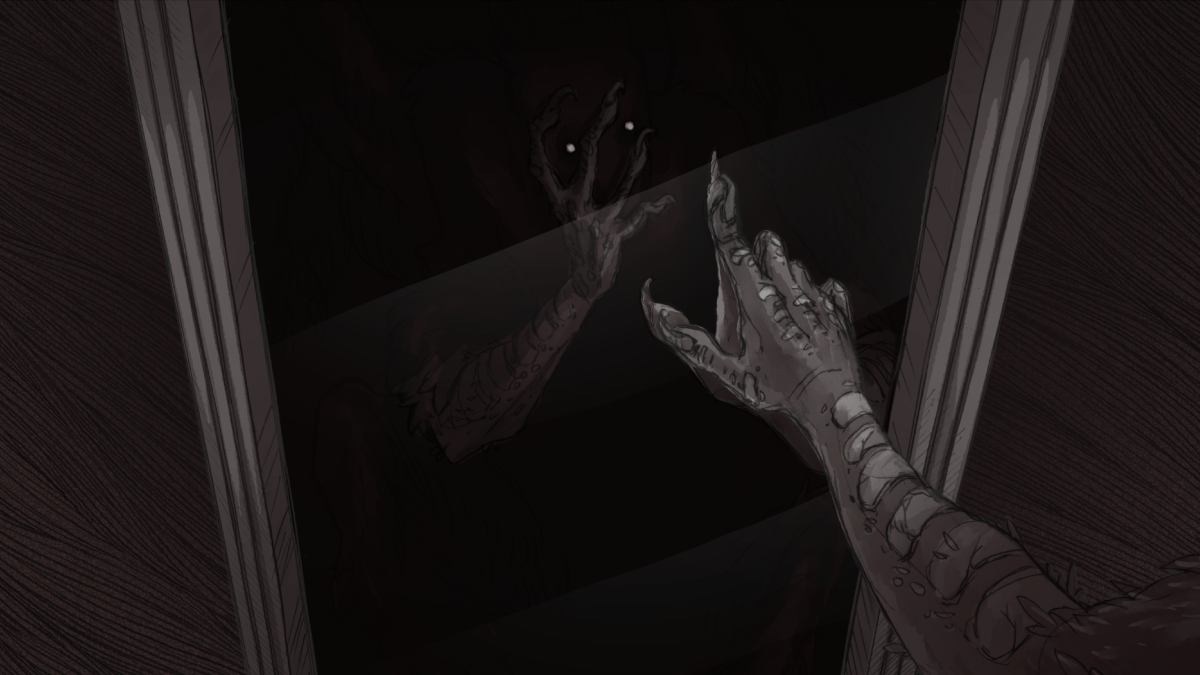
The Long Quiet is the pawn at the center of The Echo and The Shifting Mound’s plans. It’s a little ambiguous as to if The Long Quiet is completely molded in the image of The Narrator. The glimpses of him in the mirror and the splash art suggest not. Even though The Princess references a beak and the ending references wings, he’s never depicted with either. The Echo claims he is ‘nothing like’ The Long Quiet, despite the mutual bird appearance and the shared voice. The Long Quiet may very well be a perfect or imperfect new version of The Echo, but he did not come to share the same personality at all.
It’s implied The Echo chained either both of them up in the cabin or The Long Quiet first. Either way, The Long Quiet broke free or was released while The Princess stayed imprisoned. The consistent broken second chain in every version of the cabin and the second shackle fitting and reacting to The Long Quiet in The Prisoner route seems to point to this. The Echo’s wording even implies he knew this would happen, as he heavily warns against examining the shackle.
The Echo’s need to shove The Long Quiet into a space by himself even when he does as asked suggests for the world to be saved, The Long Quiet must be effectively locked away again. His power is able to destroy The Princess, yet also shape her for The Shifting Mound’s plan. It’s also worth noting the mirror cycle has The Long Quiet experiencing the entire cycle of birth to decay, a motif that comes up again in The Nightmare route.
The Long Quiet: Powers and story
Perhaps if The Shifting Mound represents death via change, The Long Quiet is either life itself, evidenced by his inability to truly die, or he’s the entirety of life and death without the cycle part, as The Shifting Mound is the cycle. Perhaps The Echo attempts to lock him away so that there is no chance of life and death itself being destroyed, or his power can in some other way ruin things.
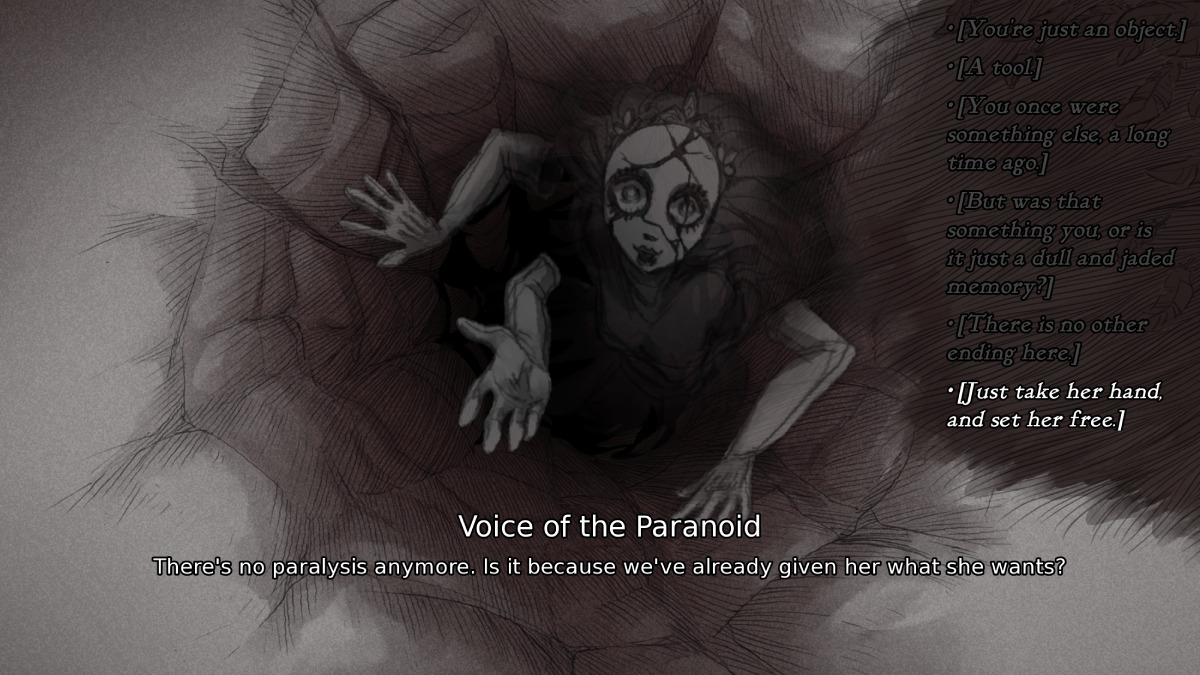
Regardless, The Long Quiet has free will The Echo and Shifting Mound/Princess have to contend against. He never changes with the chapters compared to The Princess. However, The Echo, Princess, and Voices all have some capacity to overpower his will. Fitting for being the player character, his story is ultimately about deciding for himself who he is and will do over what everyone else wants to use him and his power for.
Character Analysis: The Princess
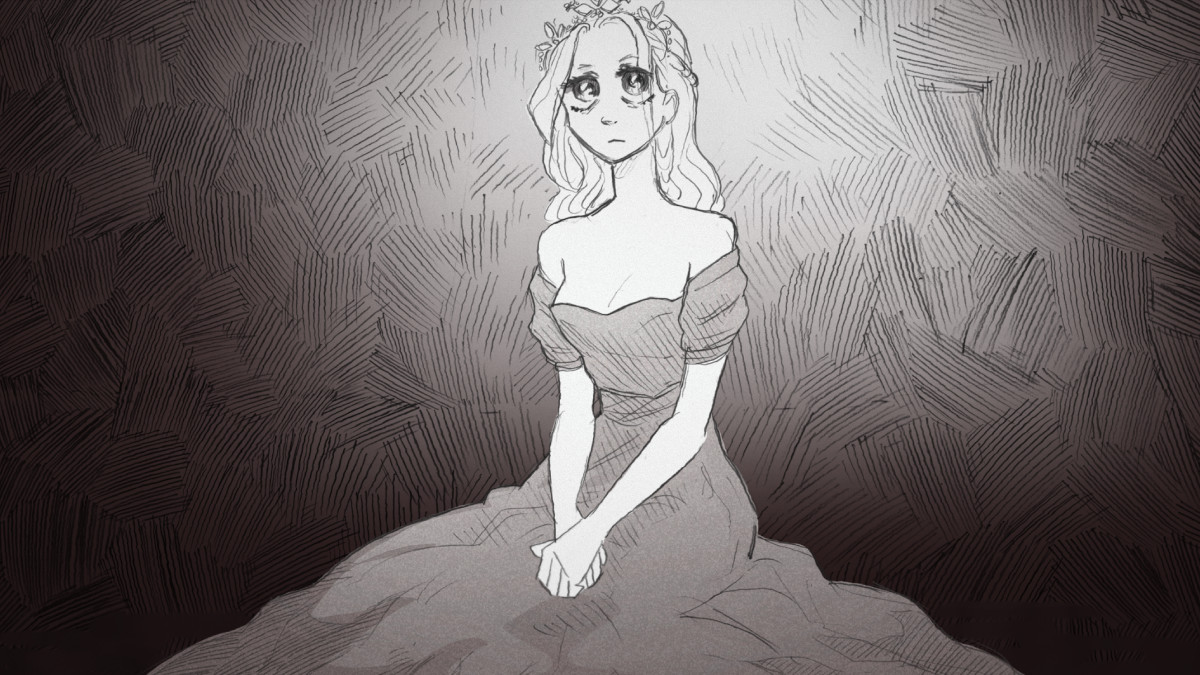
The Princess becomes what others perceive her to be. She’s a Princess because the Hero wanted to imagine her so. Like The Long Quiet, she is not a real person, nor does she have any actual kingdom she rules over.
There is a lot about her gauged by putting everything together. She has a lot of anger due to her imprisonment, hopeful about escaping but guarded with her precarious position. She tries keeping her anger contained, but The Long quiet pushes it to a brink in some chapters (Beast, Witch, Fury, Wraith). Her hopeful side is embodied especially in Damsel, the only chapter she truly lets down her guard. But her general willingness to try and give The Long Quiet a second chance (Spectre, Nightmare, Tower, Thorn, Wild) is indicative of how lonely and longing she is for company.
Adversary and Razor’s regarding of The Long Quiet as a fun opponent to enjoy fighting shows she finds company in The Long Quiet even if he hurts her. Only Wraith, Beast, Drowned Grey, Fury, and Witch seem to truly despise The Long Quiet. Furthermore, even her more grandiose forms (Tower) are likely a cover up for how little self-esteem she has (Thorn) due to being locked away and framed as a monster.
The most intriguing route to analyze for me was Nightmare, when she pulls off her mask. She uses imagery of herself to make The Long Quiet painfully aware of the cycle of life and death, but makes it sound as if she’s been continuously living and dying a full life in the cabin. She even shows imagery of a life where she had a successful career and children. Whether that’s true or just part of the Nightmare imagery is never really explained.
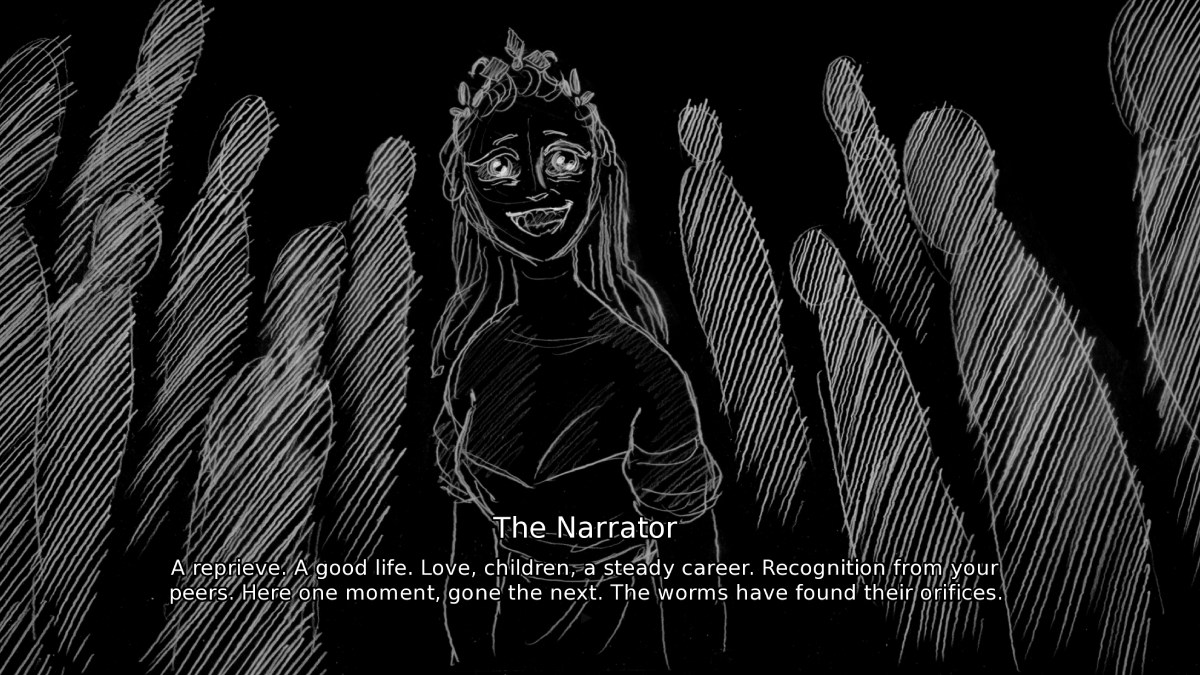
The true Princess
If The Long Quiet talks to The Princess in the cabin at the end of the game, she’s sincere and herself. It’s as if through the trials of the construct, all her anger and mistrust has been put aside and she did find a way to trust The Long Quiet as her only companion.
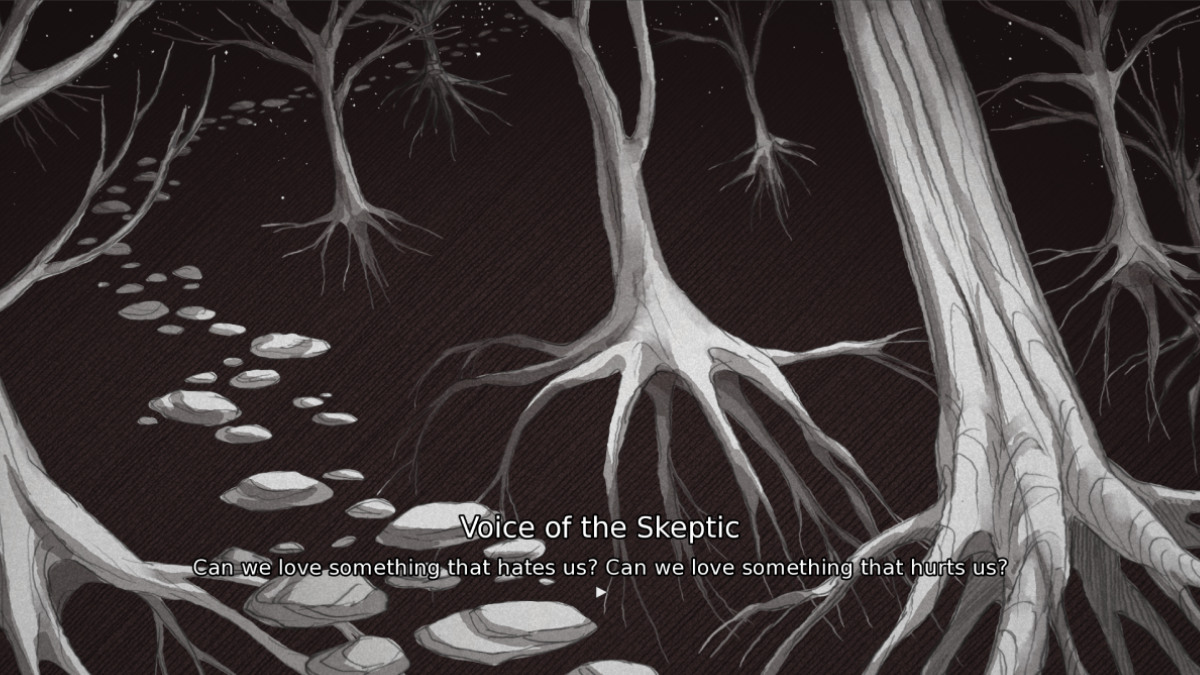
The Princess has been left to be nothing in her existence. Now without The Echo and The Long Quiet as enemies, the ending in which The Long Quiet leaves the cabin with her shows she does have a true self, and she is finally free to explore the unknown with it. Otherwise, even in her dying words she doesn’t have any ill will left towards The Long Quiet.
Character Analysis: The Narrator/The Echo
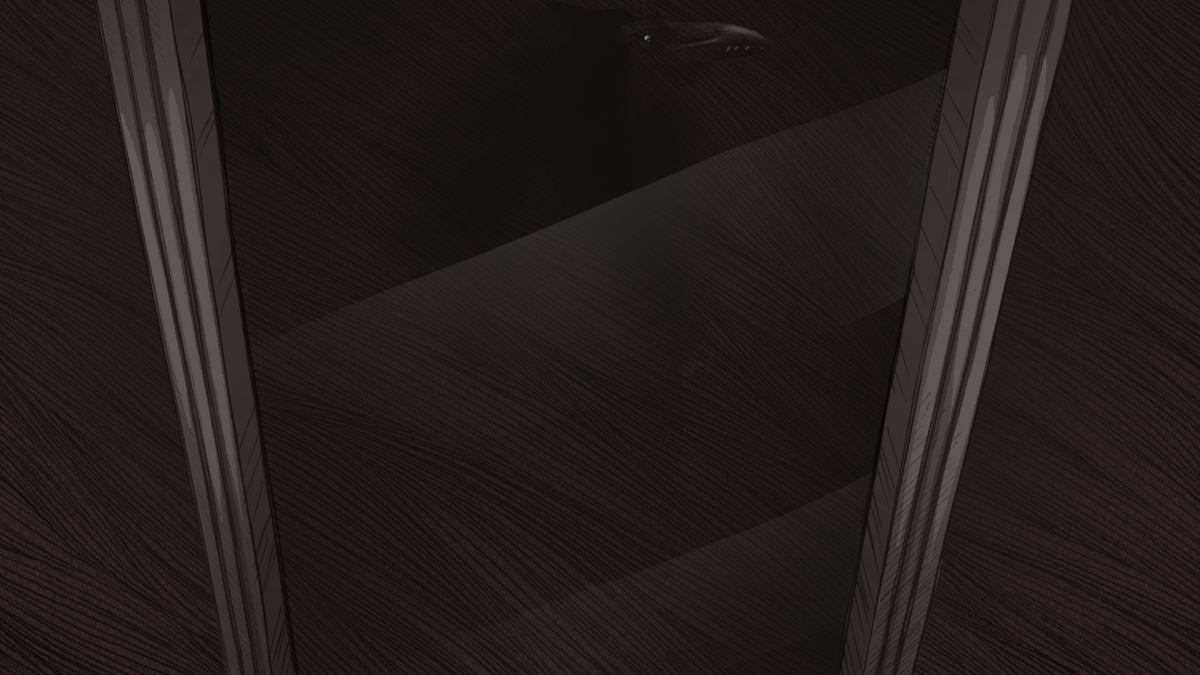
While none of the characters are real, The Echo is at least the remains of what was once a normal, mortal person. He witnessed his world doomed to oblivion. To save it, he somehow tore apart the cycle of life and death, then killed himself to prevent empowering The Princess.
While The Echo ultimately does not regard The Long Quiet, Voices, or The Princess as their own people- to be expected, since they aren’t really- he does at least have a form of concern and care for The Long Quiet at times. Perhaps that’s to be expected, if The Long Quiet is truly made in his image.
There are three chapters in which The Princess can interact with The Echo. Spectre seems hopeful The Echo doesn’t hate her, Wraith regards him as an obstacle, and Tower (plus Shifting Mound later) insults him as a weakling trying to control forces he can’t and takes him over.
The tragic edge of The Echo
The Echo reads to me as someone who behind all of his controlling behavior and manipulation, is deeply traumatized. He stays calm because he has to, but a few lines of dialogue hint that witnessing his world on the brink of oblivion destroyed him so much that all the remains of his psyche has left is this single desire to prevent the end of everything. He’s willing to make a couple gods he shaped suffer endlessly to save everyone who is real and matters. He constantly emphasizes the world out there because he is the only character who knows what it was like, and he cares an incredible amount for it. Yet for all he tries, even he cannot hope to contend with two godly forces as a mere echo of a mortal.
There’s something deeply tragic about The Echo as a character. He sacrificed himself to try and save everything he loves, but to no avail in most outcomes. Whether there was ever truly a chance of saving his world, or if he’s hopelessly deluded and traumatized to try and prevent an outcome that will always occur, is left ambiguous in the end.
Character Analysis: The Voices, as a whole
In the context of Slay the Princess’ story, The addition of The Voices in The Long Quiet’s head may be the part of The Shifting Mound left over inside of him. However, Broken claims The Princess smashes The Long Quiet into smaller pieces, and The Spectre calls the Voices shards of glass. Much as The Echo is split into pieces, it seems The Long Quiet also splits into pieces, and those split pieces of glass are The Voices. The Voice of the Hero says there’s still a piece of him near the chapter one cabin, meaning even he splits off into pieces of glass.
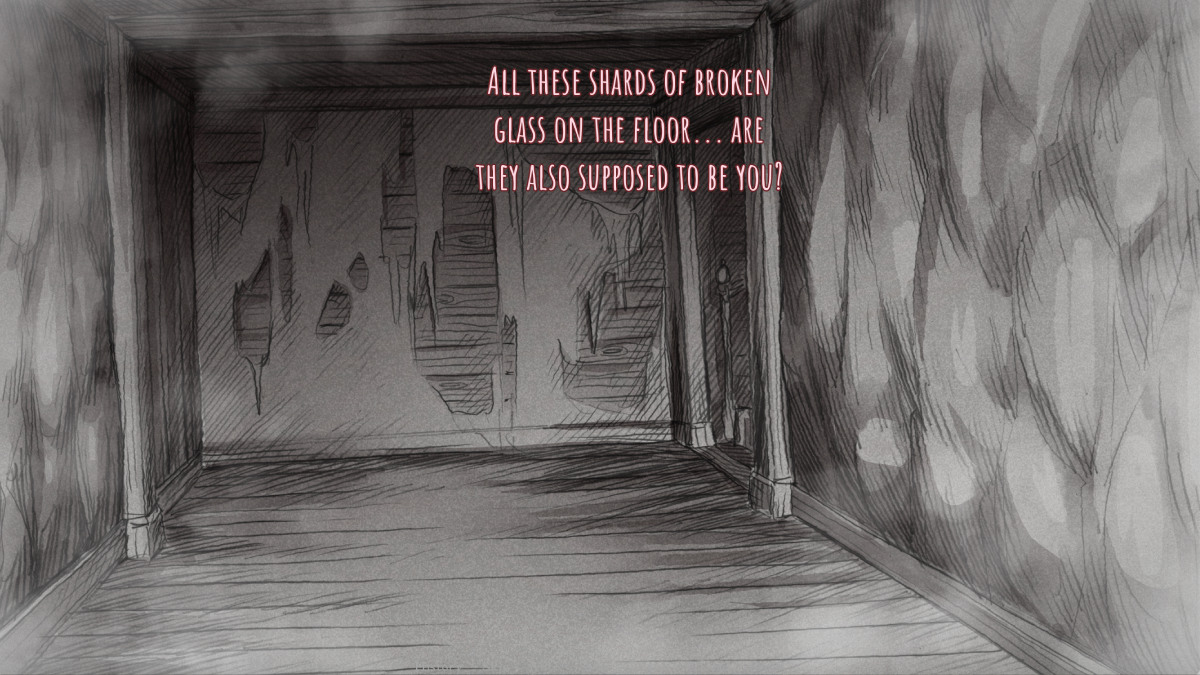
Yet it’s undeniable The Voices are The Long Quiet’s thoughts, as they’re called as such and emptying your mind in The Razor gets rid of everyone including The Echo. While not as strong as The Echo, Voices are still capable of overpowering The Long Quiet in certain instances and making decisions. Even if they can’t, their mere presence influences The Long Quiet’s strength. This is shown by The Broken being labelled the main reason The Long Quiet has trouble resisting The Tower. Interestingly enough, Voices can leave if they choose to. The Voices seem to follow the same logic as The Princesses do to The Shifting Mound. They are a part of The Long Quiet, but they’re also their own persons.
The Voices get either lost in The Long Quiet or absorbed into The Shifting Mound unless The Hero slays The Princess, at which point they reappear with him. If The Hero leaves with The Princess, they all presumably continue to exist out somewhere. It’s unknown if they can come back once they leave the two behind, but Hero and Contrarian did come back already once before they opted to leave again.
The Voices, individually
- Hero: Always most in line with The Long Quiet’s current thoughts. The voice of reason (quite literally). He’s hesitant to outright slay the Princess, preferring to opt in for being reasonably cautious, but is unnerved by the strangeness that arises, and tries to get The Long Quiet out alive. Represents The Long Quiet’s most true self.
- Cold: Bored and apathetic. He’s completely unfeeling except for irritation and considers himself above the other Voices for being emotionless. His motivation seems to revolve around boredom- he supports just doing whatever is different than before with no care for the consequences. Represents the apathetic part of The Long Quiet who successfully kills the Princess without feeling.
- Stubborn: Impatient and bullheaded, always wanting to do things with brute force and head on. He’s focused on fighting The Princess. Represents The Long Quiet’s enthusiastically violent side.
- Broken: Completely given up on resisting The Princess, miserable with no self esteem. Represents the learned helplessness The Long Quiet develops from being curbstomped by The Princess.
- Hunted: Concerned with how to stay alive. He’s the most problem-solving of all the Voices, actively thinking and trying to make a plan at all times. Represents The Long Quiet’s survival instinct.
- Opportunist: A slimy, two-faced liar who always sides with whoever is in power to play his cards. His entire motivation revolves around trying to backstab whoever he can to get on top. He represents the part of The Long Quiet who takes the low road.
- Contrarian: Loves to do whatever isn’t the practical decision just to piss off The Echo. He’s actually fond of The Echo and messing with him rather than malicious, but has regrets about how much his antics can actually hurt things. Represents The Long Quiet’s capacity for messing around and not taking the task seriously.
The Echo Distrusting Gang
- Paranoid: On edge and distrusting, but deals with his fear head on when it surfaces in the form of Nightmare, though he also dislikes The Echo. He represents The Long Quiet’s fearful reaction to The Princess and everything else.
- Smitten: A self-admitted airhead who is only driven by his love for The Princess. He’s a blind optimist who thinks love can overpower anything, even that which it logically cannot. He represents an exaggerated version of The Long Quiet’s unwavering optimism.
- Cheated: Pissed about the unfairness of the situation, and all the ways the rules of the construct seem rigged against the gang. He never really offers any attempt at problem solving and just complains. He represents’ The Long Quiet’s inability to ‘win’ at the task.
- Skeptic: Extremely distrusting of the logic of the construct, and seeks to unravel and figure out what’s really going on here. He represents The Long Quiet’s doubts about everything he is being told to do.
Slay the Princess: The Story explained- A surreal love story of the nature of life and death, change, and happiness
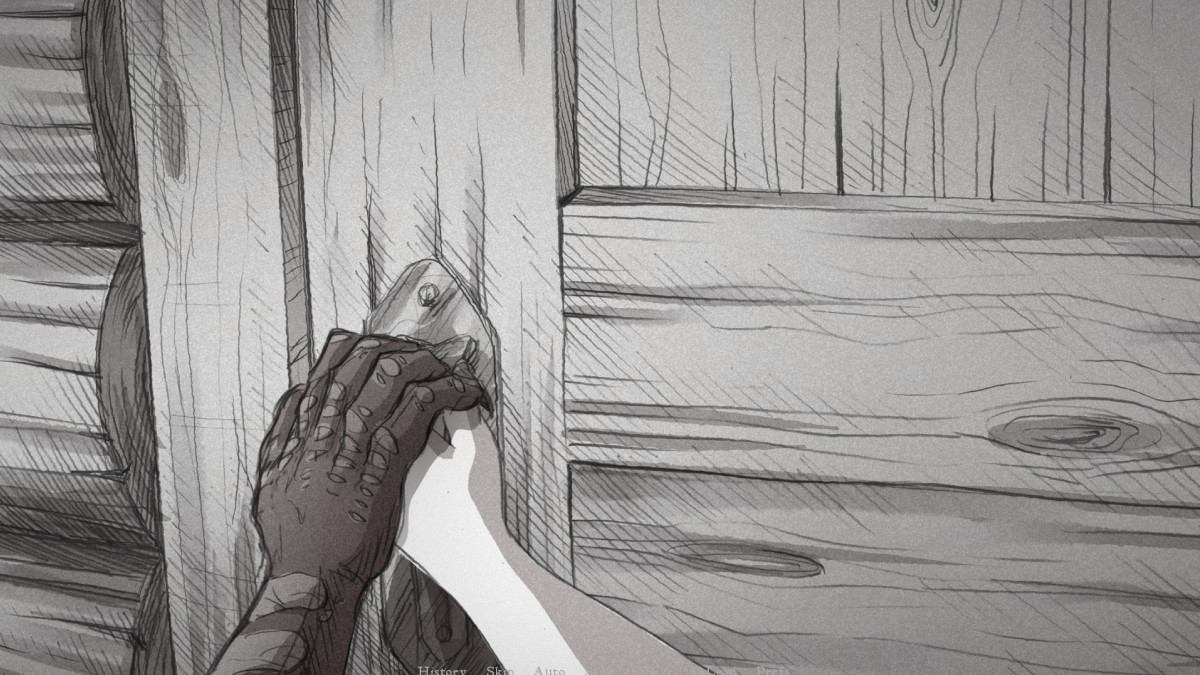
When it comes down to it, the main conflict of the game is between change and stasis. The Echo believes that hiding away from the end of his decaying world by stopping everything leads to endless bliss for his world and everyone in it. The game emphasizes the horror of death and decay over and over. But would everyone truly be happy if they were immortal and stuck forever? Or is The Echo delaying an inevitability, and the only true solution is to follow The Shifting Mound and allow the two gods to make new realities and worlds entirely? Is freezing one existence in place to save it worth denying all new life and possibilities that come afterward?
Ultimately, the player/The Long Quiet decides. You presumably condemn The Echo’s world by ascending to godhood or leaving the cabin with The Princess, but it’s not clear if the world is saved or made anew anyhow if you slay the Princess. The Long Quiet has no way of knowing, as he is not part of the world. So does The Long Quiet choose to indulge stasis and exist alone, or will he weave a new tale of existence together with The Princess, allowing roses to bloom on new grass on a new day?
Like The Echo tells The Long Quiet repeatedly, there’s always a choice. But no one knows if the right one is, or truly can, be made. And that is the inherent ambiguity of Slay the Princess, bringing us to the end of Slay the Princess’ story.
More Slay the Princess articles